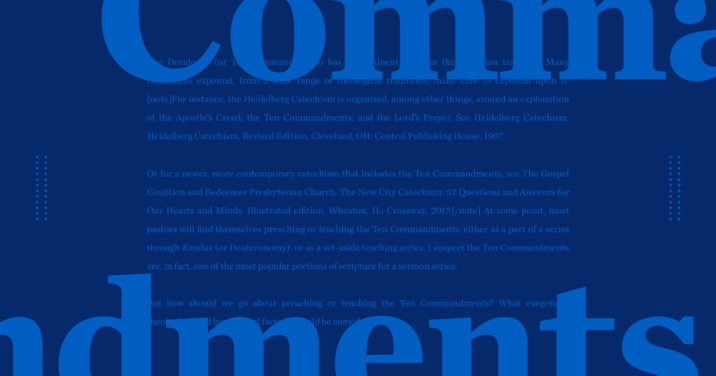The Decalogue (or Ten Commandments) has a prominent place in the Christian tradition. Many catechisms, from a wide range of theological traditions, make sure to expound upon it.1 At some point, most pastors will find themselves preaching or teaching the Ten Commandments, either as a part of a series through Exodus (or Deuteronomy), or as a set-aside teaching series. I suspect the Ten Commandments are, in fact, one of the most popular portions of Scripture for a sermon series.
But how should we go about preaching or teaching the Ten Commandments? What exegetical, theological, and homiletical factors should be considered?
1. Method
The first question any preacher will need to answer when considering preaching the Ten Commandments is, “How do I go about to preaching these commandments?” By that I mean, will you be preaching Exodus 20 as simply the next passage in an expositional series through the entire book of Exodus, or will you be preaching the Ten Commandments as a stand-alone series?
Additionally, what will be the textual boundaries for your sermon or sermons? Will you preach each of the commandments as its own individual sermon, or will you preach them all together as a whole?
If you are preaching through the book of Exodus expositionally, you will want to preach Exodus 20:1–21 as a unit—or even arguably all of Exodus 19:1–20:21, situating the Ten Commandments within that larger passage as a whole.
2. Context
Situating the Decalogue in its context will be necessary regardless of what preaching method one chooses, of course. The Ten Commandments did not simply fall from the sky, nor do they come to us in a textual vacuum. Rather, these commandments express the stipulations of a particular covenant (the Mosaic), belonging to a particular people (Abraham’s seed), as part of a particular story of redemption: God’s deliverance of Israel in fulfillment of the Abrahamic covenant (Gen 15:12–21).
The book of Exodus begins by showcasing the fulfillment of those promises. Despite severe, even deadly, opposition from Pharaoh, Israel continues to “multiply” (used four times in Exod 1:1–22), recalling God’s promise to “multiply” Abraham’s offspring and make them into a great nation (Gen 12:2; 15:5, 17:6; 22:17; 26:4). And when God responds to Israel’s oppression by appointing Moses to lead their deliverance, we are specifically told by the narrator that this was because “God remembered his covenant with Abraham, with Isaac, and with Jacob” (Exod 2:24; cf. 2:23–25; 3:6 15, 16).
From the outset, then, God’s deliverance aims not merely to rescue Israel from oppression (although that is certainly a significant aim), but to achieve these covenant purposes—to make Israel his people, his “firstborn” son (Exod 4:22). In other words, God delivers Israel not merely from something (Egypt), but to something, namely, God’s mountain (Exod 3:12; 15:17) where they will serve him (Exod 4:22–23)—and then, after that, rest in the promised land. As God explains in Exodus 4:6–8,
I am the Lord, and I will bring you out from under the burdens of the Egyptians, and I will deliver you from slavery to them, and I will redeem you with an outstretched arm and with great acts of judgment. I will take you to be my people, and I will be your God, and you shall know that I am the Lord your God, who has brought you out from under the burdens of the Egyptians. I will bring you into the land that I swore to give to Abraham, to Isaac, and to Jacob. I will give it to you for a possession. I am the Lord.
Exodus 19–24 then recounts God’s covenant-making with Israel2 after delivering them from Egypt and leading them to the mountain. Here God enters into relationship with Israel, making them his people, his “treasured possession,” “a kingdom of priests and a holy nation” unto God (Exod 19:4–6). The Ten Commandments function in this wider context as describing what this new relationship ought to look like, how Israel is now to act as God’s redeemed, holy people. In other words, the Ten Commandments show what redeemed life is to look like for Israel, the demands of this covenant relationship.
The Ten Commandments show what redeemed life is to look like for Israel.
That said, as readers, we are already clued in to the fact that Israel is not exactly likely to succeed in this calling. Immediately following her redemption, and just prior to this covenant-making, Israel has already demonstrated a pattern of disbelieving disobedience, with much of Exodus 15:22–18:27 serving to highlight Israel’s insubordination and ingratitude (note the repetition of “quarrel” and “grumble” in this section). By the time we come to Exodus 19–24, as Israel confidently proclaims, “All that the Lord has spoken we will do” (Exod 19:8; 24:3, 7), the reader should be incredibly skeptical. This isn’t going to end well for Israel, as the closing blessings and curses make clear (Exod 23:20–33). After God issues the Ten Commandments, the people respond to God by recoiling in fear (Exod 20:18–21), leaving us with the impression that God’s holiness, and his demands, are simply too much for them. And as the narrative continues, no later than Exodus 32 will Israel break this covenant.
What difference does any of this make for preaching? First, we ought not to preach the Ten Commandments as some abstract moral code or as simply an ethics lesson. Rather, God’s law comes to his people as part of the outworking of his redemptive purposes—not that the law itself is redemptive (saves), but rather it gives shape to this redemption.3 God’s law is part of God’s good redemptive purpose to restore a people for himself, the law expressing what it looks like to live as that redeemed people.
Second, the context of Exodus 20:1–17 makes plain that Israel will prove unable to keep these commands. Thus, the message of Exodus 20:1–17 in context—and by extension, our message to our own audiences—will present these commandments as standards we, as reflected in Israel’s own experience, are unable to keep in our own strength. We must preach the Ten Commandments, in other words, from the vantage point of our status as law-breakers.
3. Grace
The Ten Commandments begin, not with a command, but with a history lesson. The preface to the Ten Commandments (Exod 20:2) reminds Israel that they are the possession of the God who has delivered them from Egypt. Their status as God’s people, with its accompanying responsibility to obey these commands, presumes and is based on God’s prior act of redemption. In other words, the Ten Commandments are not set forth as a means by which Israel achieves her redemption or earns a relationship with God, but as a response to God’s redemption already accomplished and reflective of a relationship already gracious given.
As Graeme Goldsworthy explains,
[W]e must not overlook the relationship of law to grace in the Old Testament.
The first word at Sinai was a word about grace (redemption) and covenant to which an obedient response was demanded (Ex 19:4–6). The same pattern of the priority of grace is expressed in the giving of the Ten Commandments. “I am YHWH (Yahweh) your God, who brought you out of Egypt,” is quite explicit (Ex 20:2). He is their God, and he has saved them. On this basis the law is given. Clearly, all the conditional statements notwithstanding, the law is given to those who have already experienced the grace of God in salvation, and it is not the basis upon which they will be saved.
The task of obedience is given because the relationship of sonship has already been established as an undeserved gift.”4
Likewise, as we preach the Ten Commandments to our own people, we must do so without presenting God’s law as a means by which we earn salvation or establish a relationship with God. Rather, our obedience results from a salvation already achieved; it is a response to the salvation we’ve received. Our holiness does not earn a relationship with a holy God, but is instead meant to reflect it: as the people of a holy God, we are to reflect his holiness in our own (Lev 19:2; 1 Pet 1:15–16). Just as in the New Testament (e.g., Col 3:3–5, “[Y]ou have died … so put to death … ”), so also in the Old, imperatives follow indicatives.
4. Continuity
As members of the new covenant, believers today are not formerly under the old covenant, of which the Ten Commandments are a part. As Thomas Schreiner explains,
Since believers are no longer under the Mosaic covenant, we’re not under the stipulations of the old covenant as a covenant. The Mosaic or Sinai covenant was enacted with Israel, not with us. Yahweh inaugurated the covenant with Israel when he freed them from Egypt. Israel’s covenant with the Lord contained both religious and political elements, and thus Israel as a nation, as a distinct people, received specific commandments for both its religious and political life. The laws given to Israel were its charter as a nation, as God’s special people in the ancient world. But the laws and stipulations aren’t the requirements for the church of Jesus Christ, which is under a new covenant (Jer 31:31–34; Ezek 36:26–27; 2 Cor 3:6; Heb 8:8–13).5
Nonetheless, despite this covenantal discontinuity, a moral continuity remains—inasmuch as the Ten Commandments express the moral character of God (what some have called the “moral law”), which is binding on all people everywhere.6 Thus, we can preach the Ten Commandments (with potentially one exception7) as expressing what God demands of his people even today.
5. Structure
The Ten Commandments (Exod 20:1–17) divide into two sections, or “tables” as they’ve been called. The first four commandments deal with our relationship to God (notice the cluster of the use of “the LORD, your God” in Exod 20:1–11). The second table, the remaining six commands, concern themselves with our relationship to our fellow humans (see the repetition of language like “your father,” “your mother,” and “your neighbor” in Exod 20:12–17).
Jesus reflects this twofold summary of the law in Matthew 22:36–40 when says that the greatest commandments are to love God and love neighbor. In fact, “On these two commandments depend all the Law and the Prophets” (Matt 22:40; cf. Matt 7:12; Rom 13:8–10; Gal 5:14). These two commands—love God and love neighbor—aptly categorize the totality of what God’s law requires.
As we preach the Ten Commandments, we must be sure to communicate both these duties.
6. Essence
In his Sermon on the Mountain (Matt 5–7), Jesus places himself in a divine role as the authoritative lawgiver. In this capacity, he explains to us the true intent (the essence) of what God’s law, such as the Ten Commandments, requires. For instance, we must not merely refrain from murder (the sixth commandment), but even the very attitude the gives rise to it: anger (Matt 5:21–22). Or again, we are not merely to abstain from adultery (the seventh), but even lust—what Jesus labels “adultery in heart” (Matt 5:27–28).
In other words, the true aim of God’s law is not minimalistic conformity to its letter, but unmitigated righteousness, reflected even in internal thoughts and attitudes. For example, the Westminster Larger Catechism expounds “the duties required in the sixth commandment” in this vein:
The duties required in the sixth commandment are all careful studies, and lawful endeavors, to preserve the life of ourselves (Eph 5:28–29) and others (1 Kgs 18:4) by resisting all thoughts and purposes, (Jer 26:15–16; Acts 23:12, 16–17, 21, 27) subduing all passions, (Eph 4:26–27) and avoiding all occasions, (2 Sam 2:22, Deut 22:8) temptations, (Matt 4:6–7, Prov 1:10, 11, 15–16) and practices, which tend to the unjust taking away the life of any; (1 Sam 24:12, 1 Sam 26:9–11, Gen 37:21–22).8
As we preach the Ten Commandments, then, we must follow Jesus’ cue by applying them in their full strength, understanding their true intent as unrestricted in scope. In as much as they reflect God’s morally binding character, they are not merely proscriptions, but implied prescriptions.
7. Function
The Protestant tradition has historically identified different “uses” (or functions) of God’s law. As we preach the Ten Commandments, we will be aided by thinking along these helpful categories.
First, the law exposes our need for salvation. By expressing God’s moral demands, the law confronts us with our utter inability to keep that law, resulting in our just condemnation (Rom 3:20; Gal 2:16). In this way, the Ten Commandments direct us to Christ, who justifies us by bearing the guilt of our law-breaking in our place (Rom 3:21–26; Gal 3:10–14). As Augustine says, “The utility of the law is, that it convinces man of his weakness, and compels him to apply for the medicine of grace, which is in Christ.”9 This is often called the “pedagogical” use of the law.
But, second, having been justified by Christ, the law instructs Christian as to what is pleasing as we now live for God. We might call this the “normative” use of the law. As the Reformation Study Bible explains,
By studying or meditating on the law of God, we attend the school of righteousness. We learn what pleases God and what offends him. The moral law that God reveals in Scripture is always binding upon us. Our redemption is from the curse of God’s law, not from our duty to obey it. We are justified, not because of our obedience to the law, but in order that we may become obedient to God’s law.10
In other words, the law directs us to the gospel (the pedagogical use); and the gospel directs us back to the law (its normative use).
As we preach the Ten Commandments, will want to be attentive and sensitive to both of these ways in which the law functions for our listeners.
8. Gospel
Finally, the Ten Commandments—and the Mosaic covenant more broadly—anticipate the Gospel with its accompanying new covenant. The law could tell Israel what to do, but it could not give Israel the ability to do it. Thus, Israel ultimately proved unable to keep God’s law, as the law itself predicted (see Deut 30:1–10; cf. Josh 24:19–22). As a result, Israel suffered the curses of the covenant, experiencing essentially the reversal of God’s redemption, as she went back into slavery in a new “Egypt” (Hos 9:3; cf. Deut 28:68). As Paul says, the wages of sin is death (Rom 6:23); so the wages of Israel’s national sin was national death; that is, exile (Ezek 37).
Nonetheless, God promises a day in which he will make a new covenant (Jer 31:31–32). The new covenant entails the forgiveness of Israel’s covenant breaking: “I will forgive their iniquity, and I will remember their sin no more” (Jer 31:34). And it will finally supply God’s people with the ability to obey his commands. No longer will the law be written merely externally on tablets of stone, but internally on human hearts (Jer 31:33; cf. Ezek 36:26; Rom 7:4–6; 2 Cor 3:1–18).
Christ fulfills these promises in the gospel, bearing the covenant curses on the tree (Gal 3:13) and ratifying the new covenant (Lk 22:20) in which God grants believers the Holy Spirit who causes them to walk in his ways (Rom 8:1–4).
Run, John, run, the law commands
But gives us neither feet nor hands,
Far better news the gospel brings:
It bids us fly and gives us wings.11
As we preach the Ten Commandments, therefore, we preach them as commandments Christ has not only fulfilled for us—in his passive and active obedience—but as commands he now fulfills in us, as he enables us to do them as well.12
Conclusion
I hope you find these considerations helpful as you preach or teach the Ten Commandments.
What other factors or considerations do you think are worth mentioning as one seeks to preach the Ten Commandments? Am I missing any that you would want to mention?
Related articles
- Expository Preaching: What It Is—and 20 Features
- Are the Ten Commandments Still Relevant?
- What Are the 8 Best Books on Preaching?
- Describing Diatheke: Covenant in the Bible
- For instance, the Heidelberg Catechism is organized, among other things, around an explanation of the Apostles’ Creed, the Ten Commandments, and the Lord’s Prayer. See Heidelberg Catechism. Heidelberg Catechism. Revised Edition. Cleveland, OH: Central Publishing House, 1907. Or for a newer, more contemporary catechism that includes the Ten Commandments, see The New City Catechism: 52 Questions and Answers for Our Hearts and Minds from The Gospel Coalition and Redeemer Presbyterian Church. (Crossway).
- Exodus 19:1–25 introduces the soon-to-be covenant relationship, showcasing the utterly overwhelming holiness of its God. Exodus 20:1–17 (the Ten Commandments) serves as something like the “center” or encapsulation of the covenant arrangement (what’s called “apodictic law”). Following this, 20:22–23:19 provides more detailed laws (called “casuistic law”), expanding on this center. Exodus 23:20–33 closes the covenant with promises of blessing for obedience and curses for disobedience. And then Exodus 24 recounts the actual ratification of the covenant with the people.
- As Graeme Goldsworthy comments, “redemption involves a relationship with God that is structured by the law.” According to Plan: The Unfolding Revelation of God in the Bible (Grand Rapids: IVP, 1991), 141.
- According to Plan, 142.
- “The Old Covenant Is Over. The Old Testament Is Authoritative,” The Gospel Coalition, November 1, 2018.
- Thomas Schreiner writes, “Yes, the old covenant has passed away in its entirety, and believers aren’t under the old covenant but the new covenant, which was inaugurated with Jesus’s death and resurrection (cf. Jer 31:31–34; Gal 3:15–4:7; Rom 6:14–15; 7:4–6; Heb 8:1–10:18). But moral norms still exist for believers. … Saying that the old covenant has passed away doesn’t mean the Old Testament is no longer (or somehow less) the Word of God. All of the Scriptures, both Old and New Testament, are the final authority as God’s infallible and inerrant word. All of the Old Testament has a revelatory and pedagogical authority for believers in Jesus Christ. … The commands that are normative for believers today aren’t normative merely because they’re in the Ten Commandments or because they’re part of the old covenant. … [T]hey remain moral norms because they express the character of God.” “The Old Covenant Is Over. The Old Testament Is Authoritative,” The Gospel Coalition, November 1, 2018. For further treatment of this subject, see Schreiner’s book, 40 Questions about Christians and Biblical Law, ed. Benjamin L. Merkle, 40 Questions Series (Grand Rapids, MI: Kregel Academic & Professional, 2010).
- Nine out of ten of the Ten Commandments are repeated in the New Testament in one fashion or another: 1. Worship no other gods (Matt 4:10; 1 Cor 8:4–6; 1 Tim 2:5); 2. Don’t make idols (Acts 17:29–30; 1 John 5:21); 3. Honor God’s name (Matt 6:9; 1 Tim 6:1); 5. Honor father and mother (Matt 19:19; Eph 6:1–2); 6. Don’t murder (Rom 13:9; 1 Pet 4:15); 7. Don’t commit adultery (Rom 13:9; 1 Cor 6:9–10); 8. Don’t steal (Matt 19:18; Eph 4:28); 9. Don’t testify falsely (Matt 19:18; Rev 21:8); 10. Don’t covet (Rom 13:9; Col 3:5). The only commandment that is not explicitly repeated in the New Testament is the fourth, keep Sabbath. Some, therefore, maintain that the Sabbath command was unique to Israel and is not binding on the people of God today. Thomas Schreiner articulates this view when he says, “The sabbath is the sign of the Mosaic covenant, of Yahweh’s covenant with Israel (Exod 31:13, 17), but believers in Christ are no longer under the sabbath command, since it’s a shadow that points to Christ (Col 2:16; cf. Rom 14:5). The sabbath points to our rest in Christ (Heb 4:1–11).” “The Old Covenant Is Over. The Old Testament Is Authoritative,” The Gospel Coalition, November 1, 2018. For a fuller treatment of this perspective, see Schreiner’s, “Good-bye and Hello: The Sabbath Command for New Covenant Believers” in Wellum, Stephen J., and Brent E. Parker, eds. Progressive Covenantalism: Charting a Course between Dispensational and Covenantal Theologies (Nashville, TN: B&H Academic, 2016), 159–188. Or for a book-length treatment, see D. A. Carson, ed. From Sabbath to Lord’s Day: A Biblical, Historical, and Theological Investigation (Eugene, OR: Wipf & Stock, 1999). Sabbatarians, on the other hand, hold that the Sabbath is a creation ordinance (Gen 2:1–3; cf. Exod 20:11), and thus that the entirety of the Ten Commandments, including the fourth commandment, express God’s moral law for all people, everywhere, at all times. Thus, the Sabbath is still binding on Christians today, normally seen now as Sunday, the Lord’s Day (Rev 1:10; cf. Acts 20:7; 1 Cor 16:2). For a fuller treatment from a Reformed Presbyterian perspective, see G. K. Beale, “The Church’s New-Creational Transformation of Israel’s Distinguishing Marks: The Sunday Sabbath Observance of the Church as an ‘Already and Not Yet’ New-Creational End-Time Reality” in A New Testament Biblical Theology: The Unfolding of the Old Testament in the New (Grand Rapids, MI: Baker Academic, 2011, pp. 775–801. For a book-length treatment of this view from a Reformed Baptist perspective, see Richard C. Barcellos, Getting the Garden Right: Adam’s Work and God’s Rest in Light of Christ (Cape Coral, FL: Founders Press, 2021).
- The Westminster Larger Catechism: With Scripture Proofs. Oak Harbor, WA: Logos Research Systems, Inc., 1996. WLC Q 135.
- Quoted by John Calvin in Institutes of the Christian Religion (Bellingham, WA: Logos Bible Software, 1997), book II, vii, 9.
- “The Threefold Use of the Law” in Sproul, R. C., ed. The Reformation Study Bible: English Standard Version (Orlando, FL: Reformation Trust, 2015), 273.
- This quotation is often attributed to John Bunyan, although probably incorrectly. Taylor, Justin. “Run, John, Run!” The Gospel Coalition, July 27, 2011.
- As Christians who believe that all of Scripture finds its interpretive center in Christ (Lk 24:25–27, 44–47; Jn 5:39; Rom 16:25–27), whenever preaching a passage of scripture we always want to be sure to ask, how does the message of this passage direct us to Christ and relate to the gospel-event? My colleague and co-pastor, Dan Allen, has developed a helpful acronym (spelling C. H. R. I. S. T.) for considering the ways different passages connect to Christ: Does this passage present a Command/ethic only Christ can fulfill or empower, Hope or promise in which only Christ can give real reason to trust and rest, Recurring theme that eventually climaxes in Christ, Ill that can only be made right and resolved in Christ, Storyline development toward the redemption accomplished in Christ, Type picturing an aspect of the Christ event? Exodus 20:1–17 would fall most clearly into the first category.







